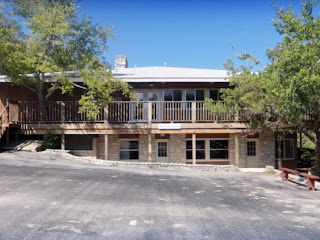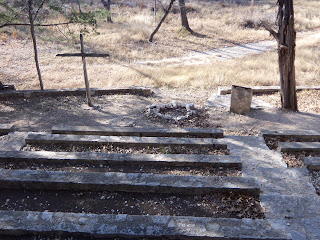The Flag Pole
The flag pole is kind of the center piece of a camp. We meet there every morning and nice to raise and lower the colors. It used to be located in front of Strong Hall and was moved over by the cabins a few years ago when Allison and the Summer '07 staff built this site. You can the remains of where the flag pole used to stand in front of Strong Hall near the GaGa pit.
Wheel & Wagon
Back in the 60's and before these were cabins that the boys stayed in. Later on in camp's life they were equestrian staff housing. Now they are used as the cleaning shed and the Ad Staff office.
Pioneer Health Lodge
Now used as the infirmary for the clinical specialists out at camp the Health Lodge has served many purposes out at camp. Ranging from a bath house to professional staff housing. The biggest debate going on about this building right now is that Ryne thinks there is an elk head stuffed in there but Bill thinks it is a axis deer.
Craft Shed
Before it became the craft shed in the late 90's it was the maintenance shop. Joseph, our current Property Manager, worked out of this until his shop was built at the front of the property. Now the craft shed is where Arts ad Crafts take place during the summer. It is cleaned out and not used in the offseason very often.
Equestrian Center
Not much is known about the history of the Equestrian Center. It has been located in the same place for quite some time now. About 20-30 horses call it home and it probably has the most animal and human traffic on camp.
LIT Pit
Built in the summer 2010 by LITs, the LIT pit is the focal point for late night embers after the dance for Farrow, Ottawa and the LITs.
The Dining Hall
The facility was built in August of 1964. It is two stories and the bottom floor is used mainly for its restrooms and overflow. Little known fact about the dining hall is that there used to be a food elevator (a small pully elevator) that would take food from the kitchen to the bottom floor. Within the past 7 years it finally got air conditioning. No more sweating during meals. The dining hall used to be located down near the pool. Next to it was the tennis courts and trampolines, both of which have been removed from camp.
The Pool
The pool was built the same year as the dining hall (1964). It also had diving boards, which has since been removed because the design of the pool makes any type of diving dangerous. It also added a shade structure added to give the kids who don't want to swim a cool place to hangout and play games.
The Gaga Pit
Built in spring 2010 it quickly became one of camp's favorite places due to the game gaga, especially during snack time. It became so popular that we built another one and put it next to the pool for kids who didn't want to swim.
The Council Ring
We don't know when it was built (it shows up in pictures from the early 50's). It is home to our campfires. It is always filled with songs and laughter. If you know anything about the history of this place, let us know.
The Blakley Chapel
Now home to daily Pow Wows, the Blakley Chapel has been around for a long time, but little is known about its history. We are currently looking to renovate the site to make it as beautiful as it deserves. Let us know if you would like to help or if you know any history behind it.






















